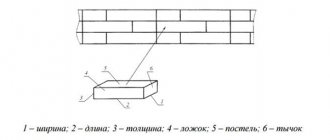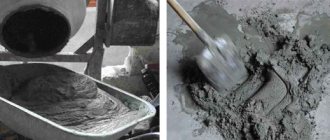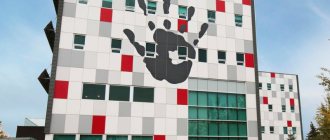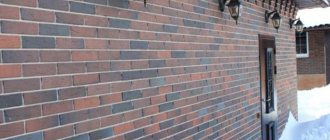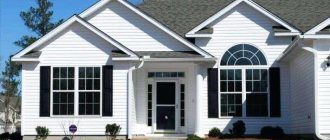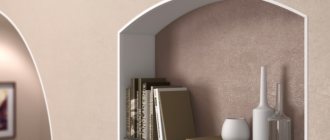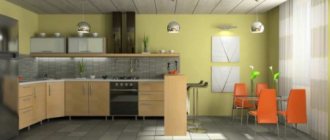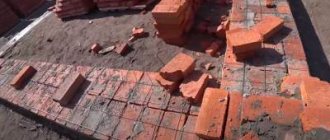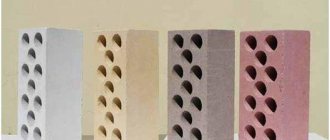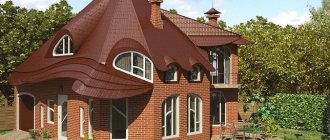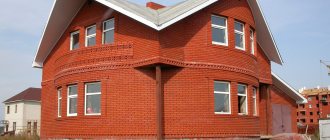Hollow or solid
Brick varies depending on the amount of air inside the block
- Solid brick is a monolithic block without cavities; according to the standard, porosity cannot exceed 13%. The use of solid bricks increases the strength of the structure, so they are used for laying the base, foundation and load-bearing walls. At the same time, solid products are considered “cold”: their thermal conductivity is 0.5 – 1 W/m*K.
Solid single row brick for the construction of load-bearing walls. The spoon has a grooved coating to improve adhesion
- Hollow brick has cavities that are made in the form of holes in the body of the brick. The holes can be in the form of slits (slotted, seven-slotted), squares and cylinders. Voids make up from 45 to 55% of the briquette volume. The air trapped in the cavities is a heat-insulating substance, due to which hollow bricks have low thermal conductivity (0.3 - 0.9). At the same time, such bricks are not used for the construction of capital load-bearing structures, and hollow bricks are also not used for structures where high fire-resistant properties are required (for stoves, brick barbecues, etc.).
Ceramic bricks for facing work, voids are made in the form of squares
The voidness affects the solution consumption during work. Some of the solution falls into the holes. If laid correctly, this should be avoided, as this will damage the thermal insulation.
- Porous brick (warm ceramics) is a type of hollow ceramic brick. The material used is low-melting clay, to which sawdust and peat are added. When these inclusions burn out, they leave cavities in the block. The strength and frost resistance grades of porous bricks reach M-200 and F-200. Thermal conductivity is 0.1 – 0.261 W/m*K.
Some manufacturers mold porous bricks for a joint system where grooves and protrusions alternate
Richness of colors - color choice
Traditionally, a brick house is presented in orange-red tones (brick color). This color is typical for ceramic bricks. The shades depend on various factors. The region of origin of the clay influences. Some varieties become yellowish or orange after firing. Pigment additives can also change colors.
Sand-lime brick is initially white in color, but after adding certain additives its color can also be changed. When using one-and-a-half masonry with facing bricks, the color of the internal masonry actually does not matter. Face masonry can be given any color using glazing or engobing.
Glazed brick has a glossy color coating
Radiated brick can have an unusual color; the external surface of the brick is filled with tints and gradients. This effect is achieved using a special firing technology. At the end of firing, the access of oxygen is limited, as a result, oxygen begins to release from the clay, forming an uneven color on the surface of the material.
Brick material
Brick is divided into types depending on the material.
- Ceramic is the most common and oldest type of brick. The raw material for it is red clay. After molding, the rectangular bars are fired in kilns. Such bricks can be used in a wide variety of areas. Initially, the material has high moisture absorption, so it is treated with moisture-repellent substances.
Ceramic brick has a characteristic red color. The shape of a rectangular bar first began to be widely used in England in the 16th century.
In terms of strength, ceramic brick corresponds to grades from M-50 to M-300. The material can be hollow or solid. Ceramic hollow bricks have one of the best performance in terms of thermal insulation.
Firing is an important technological procedure in brick production. Burnt brick will have black spots. Unburnt has a light pink color. Both technological defects affect the characteristics of the material
- Sand-lime brick consists of a mixture of lime and sand. Temperature treatment does not take place in an oven, but in an autoclave - a heating apparatus that creates pressure above atmospheric. The mass fraction of lime and moisture does not exceed 10%. It is used in dacha urban construction. The material is used for internal partitions, as it has good sound insulation. Due to its fragility, it is not used for load-bearing structures and bases. Sand-lime brick does not retain heat well, so it needs additional thermal insulation. Sand-lime facing brick is more suitable for hot and dry climates, ceramic - for areas with high humidity.
Sand-lime brick for cladding facades of European standard
- Clinker bricks are made from high-density clay. The material should not contain impurities of chalk and alkali metals. The material is used for street construction: paving paths, curbs, retaining walls and cladding plinths. Clinker brick has a high density (up to 2100 kg/m3) and low porosity (up to 5%), which means it practically does not absorb moisture.
Clinker brick in chocolate color is suitable for decorative facade masonry
- Fireclay (fireproof) brick is made from fireclay - fireclay. The main properties are low thermal conductivity, high cyclicity and resistance to high temperatures. It has the ability to accumulate and slowly release heat. Fireproof material is used in the construction of stoves, chimneys, barbecue grills and other structures that require resistance to high temperatures.
Outdoor oven made of fireclay bricks for barbecuing
- Hyper-pressed brick - bricks of this type are used for facing work, to give the facade the final appearance. Various limestone rocks are used in production. Such rocks include shell rock, marble chips, etc. Cement plays the role of a binder. Molding occurs using high pressure (20 MPa). The disadvantages of hyper-pressed brick include significant weight, so when building from it, a reinforced monolithic foundation will be required.
Brick sizes: domestic and European standard
The brick has the shape of a parallelepiped, its smallest face is called a “poke”. The wide edge that is laid on the solution is called the “bed”. The outer edge, the front part of the stone, is called the “spoon”. For spoon and poke, according to domestic standards, they are stable values. The height of the spoon varies; according to this parameter, three types are distinguished:
- single – 250x120x65 mm;
- one and a half – 250x120x88 mm;
- double – 250x120x130 mm.
Knowing the dimensions helps determine the type of masonry, its spacing, and allows you to accurately calculate the required amount of material. For cladding and finishing work, preference is given to single bricks. One-and-a-half is used for backfilling walls, and double is used in the construction of large structures. There are bricks on the market that were imported from Europe or produced on European equipment according to the standards accepted in these countries. The following formats can be found:
- DF – 240x115x52 mm;
- 2DF – 240x115x113 mm;
- NF – 240x115x71 mm;
- RF – 240x115x61 mm;
- WDF – 210x100x65 mm;
- WF – 210x100x50 mm.
Imported brick belongs to the category of facade materials and is used for cladding buildings and finishing work.
Types of bricks according to purpose of use:
- Ordinary brick.
Ordinary brick (building brick or also called standard brick, red brick, wall brick, backfill brick, clay brick, rough brick, working brick) is widely used for building foundations, as well as constructing reliable load-bearing structures. It can be subsequently painted or plastered. Thanks to this, the brick does not need to be given high aesthetic external qualities. Because of this, a block of this brick has a heterogeneous structure and color, it may have various defects, etc., but this is not of particular importance, since it in no way affects the strength indicators of a brick of this kind and this indicator is fully consistent state standard.
— Facing brick.
This type of brick (facing brick, facing brick, finishing brick, facade brick) can be characterized as a good facing building material, free of foreign defects, uniform in color. These qualities are especially valued among facing materials. When producing it, it is important to comply with all recipe standards and manufacturing technology, otherwise unnecessary foreign inclusions may appear, or disturbances in the structure of the limestone layer may be found. For bricks with limestone inclusions, moisture is very dangerous, since a chemical reaction can begin that violates the integrity of the building material. According to GOST requirements for all qualities of bricks and their appearance, deviations in size for this type of brick should not be more than 4 millimeters in length, 3 millimeters in width, and a couple to three millimeters in thickness. However, unlike rough brick, facing brick meets the standards much better and is observed with high precision. Experts distinguish two types of facing bricks: textured brick, which has a relief surface, and shaped brick, which is used for finishing window openings, cornices and other decorative facade parts of the building. The non-standard form and structure helps to create a truly unique design of any building, giving roundness to the edges and erecting arched structures.
Rice. 1. Basic colors of facing bricks.
Ivory, Straw, Red, Terracotta, Brown
— Fireclay brick.
This type of brick is intended for both interior and exterior decoration of various fireplaces and stoves. Since it must meet the highest operational requirements, fireclay brick has good density, high weight, is resistant to strong heat and is able to withstand temperature changes of the order of 1000 degrees. As a rule, refractory bricks have a yellow (sand) color.
— Clinker brick.
The name of this type of brick comes from the name of the technology used in its manufacture. During this procedure, individual clay layers are sintered until a solid mass is formed. As a result, the formation of many defects that appear in the form of structural disturbances and foreign inclusions can be avoided. Since clinker brick is homogeneous, it is a truly strong building material with increased wear resistance. And the fact that there are no restrictions on texture and colors allows it to cover the numerous needs of the construction market, because it can be used to perform a wide range of works, such as paving, cladding, etc.
Strength grade
The strength grade of the brick determines the maximum permissible load per 1 sq. cm. stone in kilograms. M150 brick can withstand a maximum load of 150 kg/sq.cm. This parameter is decisive when choosing material for various structures. The most common brick strength grades are:
- M50 – used in the construction of verandas and gazebos;
- M75 - used in the construction of interior partitions;
- M100 - this type is intended for load-bearing structures of 1-2 storey buildings;
- M150 – used in the construction of 2-3 storey buildings;
- M200 - used in the construction of multi-storey buildings;
- M300 – brick is intended for the construction of basement floors and foundations of multi-storey buildings.
The strength grade of clinker bricks can reach values of M1000.
Molding: plastic and semi-dry molding
One of the main technological processes in brick production is molding. Two methods are used - plastic and semi-dry molding. For plastic molding, raw materials with a moisture content of 15-21% are used. They work on screw presses, squeezing out blanks of the correct shape. Vacuum installations are used to produce hollow bricks. The moisture content of raw materials during semi-dry molding is lower - 8-14%. The blanks are pressed in special molds before firing. Low humidity allows you to maintain shape during the firing process. The result is high-quality material with ideal geometry.
Brickwork
In the photo, the brick in the finished masonry may look different. The overall impression is influenced by the type of masonry. An experienced master practices a variety of options. Depending on how the spoon and poke alternate, how the position of the brick is shifted, the pattern changes. The most common types of masonry:
- half-brick spoon - the brick is laid out only with a spoon, the top row is shifted relative to the bottom row by half a brick;
– laid with a slight offset of the top row to the bottom;- diagonal spoon in a quarter of a brick - when laying, the diagonal displacement pattern is strictly maintained;
- butted - only the butt faces the front side, used when laying one or two bricks;
- chaotic - spoons and pokes alternate in rows in random order;
- cross - one row is laid out with a spoon laying, the next - with a butt, while the butt is located above the center of the spoon of the bottom row. As a result, a cross pattern is formed;
- chain - the poke is laid in a row through two spoons, as a result, this type of masonry acquires a pattern reminiscent of a chain.
Several popular types of masonry get their names based on geography:
- Dutch - a row is laid out with bonded masonry, the next row is laid out with a combined one (one spoon, one poke). The joint in the combined row should be located above the seam of the jointing of the bottom row;
- Flemish - all rows are laid out in combined masonry, the pin of the top row should be located above the center of the spoon of the bottom row;
- Gothic - combined rows are laid out with a slight offset, as a result of which a vertical “pigtail” is formed from the pokes;
- Silesian - resembles Gothic masonry, but in a combined combination two spoons and one poke are laid.
The pattern of the masonry plays an important role when choosing brick as a facade material. The thickness of the wall can be different: one, one and a half, two bricks. The length of the spoon is taken as one brick; the thickness of the masonry joint must be taken into account in the calculations. The thickness of a wall of two bricks is 510 mm. The choice of masonry based on this parameter depends on the load for which the structure is designed. External and load-bearing walls of private houses are laid in 2-2.5 bricks, and partitions - in half a brick or brick. Thermal characteristics of structures and the presence of additional insulation in the project play an important role. All types of bricks are laid with cement-sand mortar or ready-made mixtures are used.
The most popular proportion of masonry mortar is 1 part cement to 4 parts sand. When using Portland cement M400, one bag will require 16 buckets of sand. The resulting mixture is mixed with 40 liters of water and mixed thoroughly. When working with clinker, it is better to use ready-made masonry mixtures designed for laying this material. Clinker has low water absorption and requires the addition of plasticizers to the solution, which will ensure the required adhesion of the masonry mortar. When choosing the type of brick, it is necessary to take into account all parameters - strength, hollowness, dimensions, geometry. Not only the construction budget, but also the service life of the finished building, operating costs and the appearance of the facade depend on this. An informed decision will allow you to buy material from which you can build a cozy, warm and beautiful home.
Types of bricks
Building material is classified according to several criteria, including:
- the material used. There are adobe (clay with fillers), clay or ceramic, silicate (based on sand and lime), hyper-pressed (base - stone chips and Portland cement) and biobrick (new development, “grown” on the basis of sand, calcium chloride, urea and bacteria option that does not require firing);
- sizes - normal, enlarged or reduced (respectively, Russian standards for ceramic GOST 530-2012 and silicate GOST 379-2015 normal size, GOST 530-2012 for ceramic enlarged). The dimensions of bricks of reduced dimensions are determined as a fraction of the usual number - ¾, ½, 1/4;
- mass (GOST 530-2012 for ceramic products) - solid and hollow of different density classes. Depending on the class and number of voids, the weight of the unit ranges from 2.34...7.38 kg;
- method of use - ordinary (construction) and facing (facade). The first is used for the construction of walls, internal and external. Depending on the number of rows of masonry, it can provide the load-bearing capacity of the wall or act as a partition. Has surface defects and requires cladding and/or insulation. The second type is ordinary or decorative, with minimal deviations and defects, used for exterior decoration of buildings, less often indoors;
- shape - rectangular or shaped. The first is used in all types of work, the second - when laying complex elements (arches, vaults, corners, etc.);
- areas of application with specified parameters (fireclay, clinker). The main task of these varieties is to withstand strong temperature changes and significant mechanical loads;
- production and molding method. Plastic molding is carried out by extrusion on special presses, semi-dry - by pressing in molds;
- blossom. There are bricks of a natural (red or white-gray) shade and painted with special pigments. The second option is used mainly as a facing, to increase the decorative effect of facades.
In addition to these basic characteristics, the material varies in quality. This depends both on production conditions (compliance with technology, choice of raw materials), and storage and transportation conditions.
Physical properties of bricks
Strength
The strength of the brick directly affects the stability and durability of the structure. The strength is determined based on the marking of the brick, which is established by the manufacturer using experimental methods - the compressive strength of the material (how many kg will 1 cm2 of material withstand).
It is customary to mark bricks as follows: the letter “M” and the number after it indicate what load the material can withstand: M100, M125, M200, M300, etc.
Recommendations for choosing the strength characteristics of bricks are as follows:
- For laying the walls of one- and two-story buildings, it is allowed to use M100 brick
- For laying the walls of high-rise buildings, bricks with a strength of at least M200 (preferably M300) are used.
- The foundation must be laid with bricks M150 and higher
It should also be noted that the higher the strength of the brick, the less damage will be caused to it during transportation.
Frost resistance and moisture absorption
The frost resistance index determines how many cycles of sudden temperature changes during the winter season the material can withstand. Frost resistance, like other physical properties of bricks, determines the durability of the material, and, accordingly, the entire structure.
Brick manufacturers use an experimental method to find an indicator of the frost resistance of a material: water-saturated brick is frozen and thawed until it begins to lose its strength properties. Bricks are marked for frost resistance as follows: put the letter “F” and next to it a number indicating how many cycles the brick can withstand and the higher the number, the better its frost resistance, and therefore its durability.
The moisture absorption of brick is also one of the most important physical properties of the material, which is interconnected with frost resistance - the lower the moisture absorption, the higher the frost resistance.
The following GOST standards for moisture absorption of the material have been established:
- Sand-lime brick (or other material to which lime is added) – up to 20%
- Brick made from white-burning clays – up to 6%
It should be noted that the frost resistance index for building bricks should be 15 cycles, and for facing bricks from 25 and above. The frost resistance of high-quality imported bricks can reach about 0, which is a very high indicator.
Frost resistance of brick
Frost resistance is the ability to withstand a certain amount of alternate freezing and thawing of bricks. It is measured in cycles and designated F15, 20...
Depending on the region of construction, the required indicator is selected - in the southern regions from F15 to F30 is suitable, in the northern regions from F30 and above.
Frost resistance indicators of individual types of bricks:
| Type of brick | Index, F |
| Silicate | 15 — 50 |
| Ceramic | 25 — 150 |
| Clinker | 100, 200, 300 |
| Hyper-pressed | 25 — 200 |
| Chamotte | 25 — 50 |
| Facing | 25 — 75 |
Tips for choosing bricks
When deciding to choose a brick for construction work, first of all, pay attention to its strength grade to make sure that the material is suitable for the job.
In addition, evaluate the conditions in which the brick will be located (oven, outer wall of the house) in order to understand exactly what properties the brick should have and how resistant it is to external influences.
Finally, evaluate the product based on its appearance. Make sure it is not cracked or chipped. And in addition to studying the appearance, study reviews about the company producing this brick on the Internet. Reviews will help you get a complete picture of the product.
Fire brick
Main types of refractory bricks
- Alumina. The most common fireclay brick, resistant to temperature changes, alkali-resistant. It has a heating limit - no higher than 1300⁰С.
- Quartz. The raw materials are quartz and sandstones, with a small addition of refractory clays. The properties are close to natural sandstone - fire resistance, but it is not resistant to iron salts and alkalis. Used for structures in contact only with metals and flames.
- Lime-magnesium varieties are not used for stoves and chimneys of private houses. These bricks are used in the metallurgical industry.
- Carbon types of bricks also have narrow applications. This high-strength brick is produced by pressing coke and graphite powders.
Ordinary ceramic brick is fire-resistant, but is not suitable for stoves and fireplaces under conditions of prolonged contact with high temperatures. For laying stoves, only refractory or fireclay bricks are used. Chamotte is a type of refractory clay, hence the name, as cokes and graphite are used as additives to increase strength. The requirements for fireclay are to withstand temperatures of at least 1800⁰C without deformation or loss of strength. The shapes of fireclay bricks are rectangular and wedge-shaped. Refractory brick has an aesthetic appearance and excellent thermal conductivity, so it is in demand not only for stove work, but also for decorative cladding of stoves, fireplaces and chimneys of cottages.
The best brick manufacturers
— Golitsyn ceramics plant. This plant has a 140-year history. For the last 30 years, it has specialized in the production of high-quality ceramic bricks, with an annual output of 120 million pieces. In Russia, it is the undoubted leader in the production of ceramic bricks, which is famous for its rich experience, widest range and consistently high quality. It actually has no downsides, except for the impossibility of purchasing products directly from the factory. But there are dozens of branded stores throughout the country.
— VKSM (Voronezh Construction Materials Plant). This company is just over 60 years old. During this period, manufacturers have accumulated a wealth of experience in the production of silicate, painted, ordinary, facing and other types of bricks. In terms of production capacity, VKSM is even ahead of the Golitsyn plant, and besides, it can boast of more reasonable prices. However, according to reviews, there are chips and uneven corners in the products.
— Slavic brick factory. This is one of the youngest, but at the same time the most advanced production facilities in modern Russia. With a release volume of 140 ml. pieces per year, the Slavic Brick Factory actively sells its products both in our country and abroad. This is facilitated by modern production lines developed in Germany. Unlike many others, the company has its own clay quarry and uses the most advanced manufacturing technologies in production. The only thing is that there are complaints that the front side of the brick may crumble during use.
— Sukholozhsky refractory plant. If you need specialized, refractory bricks, pay attention to the products of this plant. It is a leader in the production of fireclay bricks and other refractory products. In terms of product range, this plant surpasses even European production, and the prices for its products are more reasonable.
— Eco-clinker. The modern production facility was built only 6 years ago, but its products have already managed to win buyers both in Russia and around the world. If previously clinker bricks were imported to our country from Europe, now Russia has the capacity to produce clinker that is not inferior in quality to its foreign counterparts. By the way, not even negative reviews about the quality of the Ecoclinker plant’s products were found. Add to this the affordable price and you will be convinced that you simply cannot find a better product for the money!
Types and characteristics of bricks based on the material of manufacture:
— Ceramic brick.
This type of brick is made from clay, sometimes a mixture of different types of clay, and after molding and drying it goes through high temperature firing (about 1000 degrees Celsius). Ceramic bricks that have not been in the oven for enough time can be identified by their color (lighter than usual) and sound (dull). A good brick has a matte surface and, when struck, produces a characteristic ringing sound. It is required that at its fracture it be porous, homogeneous and light. If a brick has deep cracks on the outside and voids inside, it is considered defective. The main requirements for finished products are presented in a special GOST for bricks (this is GOST 530-2007 “Ceramic bricks and stones”).
— Silicate brick.
This type of brick is made from a mixture of sand and lime. Its main advantages are good sound insulation and reduced thermal conductivity. Thin walls built from sand-lime brick will have the same sound insulation and heat preservation characteristics as much thicker walls made of ceramic brick. Its disadvantage compared to ceramic brick is its lower moisture resistance. That is why white brick is used only in the construction of walls and partitions, however, it is not used in the construction of fireplaces, foundations, stoves, etc.
— Hyperpressed brick.
This type of brick is made from a special mixture consisting of 90% limestone, another 8% from cement and two from a special dye. The mixture is pressed in special forms, resulting in a bar that is ideal in shape and color, which is used for various types of finishing and facing work. Hyper-pressed bricks are also produced with a heterogeneous structure, used for cladding under the so-called “torn stone”.
Which brick is better, solid or hollow?
The brick can be solid or hollow. This is determined by the presence of holes in the brick. A solid brick is considered when there are no holes at all or their percentage relative to the total volume of the brick does not exceed 13%. This type of brick is heavier and more durable. But the disadvantage of such a brick is that it loses heat very quickly due to the lack of an air gap. We’ll talk about what solid bricks are used for below.
Solid and hollow brick
Hollow brick the presence of holes. These holes can be of various shapes and sizes. The air in these holes gives such bricks excellent thermal insulation properties. But also because of these holes, the strength of such a product suffers. Read more about the applications of hollow bricks below.
Application of solid bricks
Solid brick
Well, we all perfectly imagine an ordinary solid brick of a reddish color. Solid brick is used to create such monolithic elements in construction as columns and vaults. Another important use of such bricks is that they are used as the basis of masonry, which after construction must be covered with plaster or other facing material. It is believed that solid brick is the most suitable option for load-bearing structures and, of course, the foundation.
Application of hollow bricks
Hollow brick is useful because it better retains heat in a house or apartment. An important feature of such bricks is that the holes make it possible to reduce material costs at the production stage; this is important when it comes to large-scale construction. The low weight of such bricks not only reduces the load on the foundation, but also facilitates the laying process. Hollow brick is an excellent material for the construction of internal partitions, as well as for facade cladding. But we must remember that under no circumstances should it be used for the construction of load-bearing structures, foundations or for the construction of furnaces.
Hollow brick
Often, during the production of such bricks, sawdust is added to the clay, which burns during firing, and voids or pores are formed in the finished product. This type of brick is called porous brick and is a type of hollow brick. This variety has excellent soundproofing and thermal insulation properties. We will talk about this type of brick separately.
Types of bricks
The modern construction market today greets us with an abundance of various wall materials. But, despite this, traditional building bricks do not lose their enormous popularity, although they are quite “old” in age. Of course, today's types of bricks differ from their ancestors - mud bricks - like day from night. They retain heat perfectly, tolerate high humidity and any temperature changes, and, therefore, are optimal for the construction of buildings in Russia. Most people distinguish between red and white building bricks. However, in reality there are many more types of bricks. The variety of types of bricks is explained by different areas of application. Brick can vary not only in shape and size, but also in its composition, and also in the technologies used for its production. Brick is one of the most popular building materials, however, it is not so easy to understand the rich variety of types of bricks.
Red brick production
The main ingredient in its production is a special grade of low-melting clay, it contains a minimum content of marl and sulfates. Special varieties are mined in open-pit mines, so plants are located near such deposits - this means significant cost savings on the delivery of the main filler to the workshop.
The natural color is red, hence the name – red brick, although the correct name is ceramic. During the manufacturing process, color pigments are often added to provide color variation. Different quarries produce clay of different shades, this is influenced by natural color pigments, so the final product from different manufacturers has its own natural shade.
The production process itself does not require expensive imported equipment. The clay mass is placed on a belt press into molds, and a vibrating stand is turned on to achieve a homogeneous mass. Then it is dried and fired. The drying process can be carried out in two ways - chamber or tunnel.
- – The chamber method consists in placing the raw material in a special chamber, where the temperature regime changes in strict sequence.
- – The tunnel method involves moving trolleys with workpieces through a special tunnel with different temperatures and humidity.
In both cases the end result is the same. The working mass is fired in ovens at 1000 degrees until the glassy mass in the product reaches 8 - 10%. If these rules are followed, high-quality ceramics are obtained, visually red-brown in color, and when struck, produces a high-pitched sound. If the production process is disrupted, the product may be unburnt, the edges of such a product are melted, the core is empty, a pale brown color and a dull sound when struck.
The properties of the finished product depend on the formation methods:
- 1. The plastic pressing method involves the use of clay with a moisture content of 15 - 30%. The workpiece is obtained by extrusion, then it is dried and fired in ovens. For the hollow type, a vacuum installation is used; this type is indicated for use in the construction of housing;
- 2. Semi-dry and dry pressing method - in this option, clay with a moisture content of 7 - 12% is used, the product is obtained by extrusion under high pressure. Drying is not used here or the process takes place in a shortened time version; such bricks have worse performance compared to the previous method, plus they have more regular shapes and geometry. As a rule, this is how facing bricks are made; the walls of buildings are covered with such bricks to give a better aesthetic appearance, the building receives an improved appearance plus additional thermal protection.
Types of ceramic bricks according to manufacturing method:
Plastic molded bricks
This type of brick is the most popular because... has no restrictions on use. It is obtained by pressing under high pressure. The formed bar goes through a drying and firing procedure. In a special oven it is heated to a temperature of 800-1000 degrees. Sometimes the temperature can be more than 1000 degrees, if required by construction regulations.
Semi-dry molded bricks
Semi-dry pressed bricks are made from clay by pressing followed by firing of the brick. For these purposes, there is not even a need to dry the brick. True, the scope of application of semi-dry molded bricks is limited, since this type of brick has a more porous structure, therefore, humidity becomes dangerous for it. As a result, it cannot be used for the construction of load-bearing walls, various fences and structures, since they will not be durable. Semi-dry pressed brick can be successfully used for the construction of internal floors and walls, because it has such advantages as a smooth and even surface and ideal geometry. Walls made from it do not need leveling at all, and this significantly saves money and time.
Characteristics of red brick
The main indicators that are looked at when choosing are:
- 1. Thermal conductivity. Ordinary solid brick does not have high thermal conductivity. Basically, only load-bearing walls or partitions are built from it;
- 2. Density. This numerical indicator must be known when carrying out design and calculation work and to calculate the loads on the foundation and load-bearing walls. Density shows its class and is expressed as a numerical value from 0.8 – 2.4. The number indicates the weight of one cubic meter of material in tons; moisture absorption. For ordinary brick these numbers are low. Therefore, this building material has increased consumer demand;
- 3. Vapor absorption. High indicators allow you to create a normal microclimate in the premises; frost resistance. Measured in freeze-thaw cycles. In our temperate climate, bricks with the F50 grade are used. In harsh northern latitudes, F75 is used. The higher the number, the better the frost resistance; fire resistance. Ceramic brick has the highest fire resistance among building materials. After all, it went through high temperatures in the production cycle. It is able to withstand temperatures of 1400 degrees! It lasts for at least 5 hours when exposed to direct fire. Reinforced concrete only 2 hours, metal structures 30 minutes;
- 4. Eco-friendly. People began to pay more and more attention to this indicator. Any variety is made from natural, pure materials; soundproofing. Average sound protection indicators do not allow laying walls in one brick. As a rule, a wall of two bricks is laid; it will protect our ears at a level of 60 dB. The thickness of such a wall is 530mm;
- 5. Durability. The digital designation indicates the load in kg per 1 cm2 of area. The higher the number, the higher the strength. Brand M200 - M300 is used for the construction of apartment buildings, brand M75 - M100 is suitable for a country house or dacha.
One of the most popular brands is M 100. Due to its low cost, it is used in the construction of low walls, partitions, and various other tasks. Modern, reliable, monolithic fences and fences are built from it. Chips and small cracks are acceptable. Excellent adhesion to concrete mortar due to the rough surface.
Shape of brick products and basic dimensions
Most options have the shape of a parallelepiped. The more strictly the parallelism of opposite edges, rectangularity and dimensional accuracy are maintained, the higher the quality of the brick.
For standard ceramic bricks, the accepted names of the sides are:
|
European manufacturers offer the brick sizes shown in the illustration.
Domestic factories produce materials with slightly different standard sizes.
Additional information about non-standard (including handmade) bricks is presented in the table.
The type and dimensions of building bricks are selected depending on the required strength and other performance characteristics, temperature conditions, required thickness and shape of the wall.
Dimensions of red brick
Standard working unit – single – 250*120*65 mm. For convenience and sometimes saving consumer money, production produces the following brick sizes:
- – one and a half – 250*120*88 mm – thanks to this slightly increased size, time is saved when laying in large volumes;
- – double – 250*120*138 mm – this is a hollow type, used in lightweight masonry, where the foundation does not allow increased loads;
- – narrow brick – 250*120*65 mm – standard size of ordinary brick;
- – thin – 250*22*65 mm – due to its unique size, it is used instead of tiles for facing work.
According to previously approved documents, the manufacturer has the right to a technical deviation from the specified dimensions within the following limits: length - 4 mm, width - 3 mm, height 2 mm. When purchasing ceramic bricks, the consumer always has the right to measure several samples of the finished product. If the dimensions are normal, you can trust such a plant.
Brick size and weight.
When choosing a brick, you need to know its dimensions. There are three main standard brick sizes used in construction:
Single brick size and weight
It is also called standard brick or single-row brick has a standard size of 250x120x65 mm, where 65 mm is the height of the brick, and the weight is 2-2.3 kg. ;
Size and weight of one and a half bricks
This thickened brick has a size of 250x120x88 mm, a height of 88 mm, and a weight of 3-3.2 kg. ;
Size and weight of double brick (Stone)
I also call it a double stone, a 2NF brick measuring 250x120x138 mm, height 138 mm, and weight 4.8-5 kg.
There are also non-standard brick sizes (restoration, European sizes, etc.). It is worth noting that the size of the brick must be known when calculating the amount of brick that needs to be delivered to the site.
